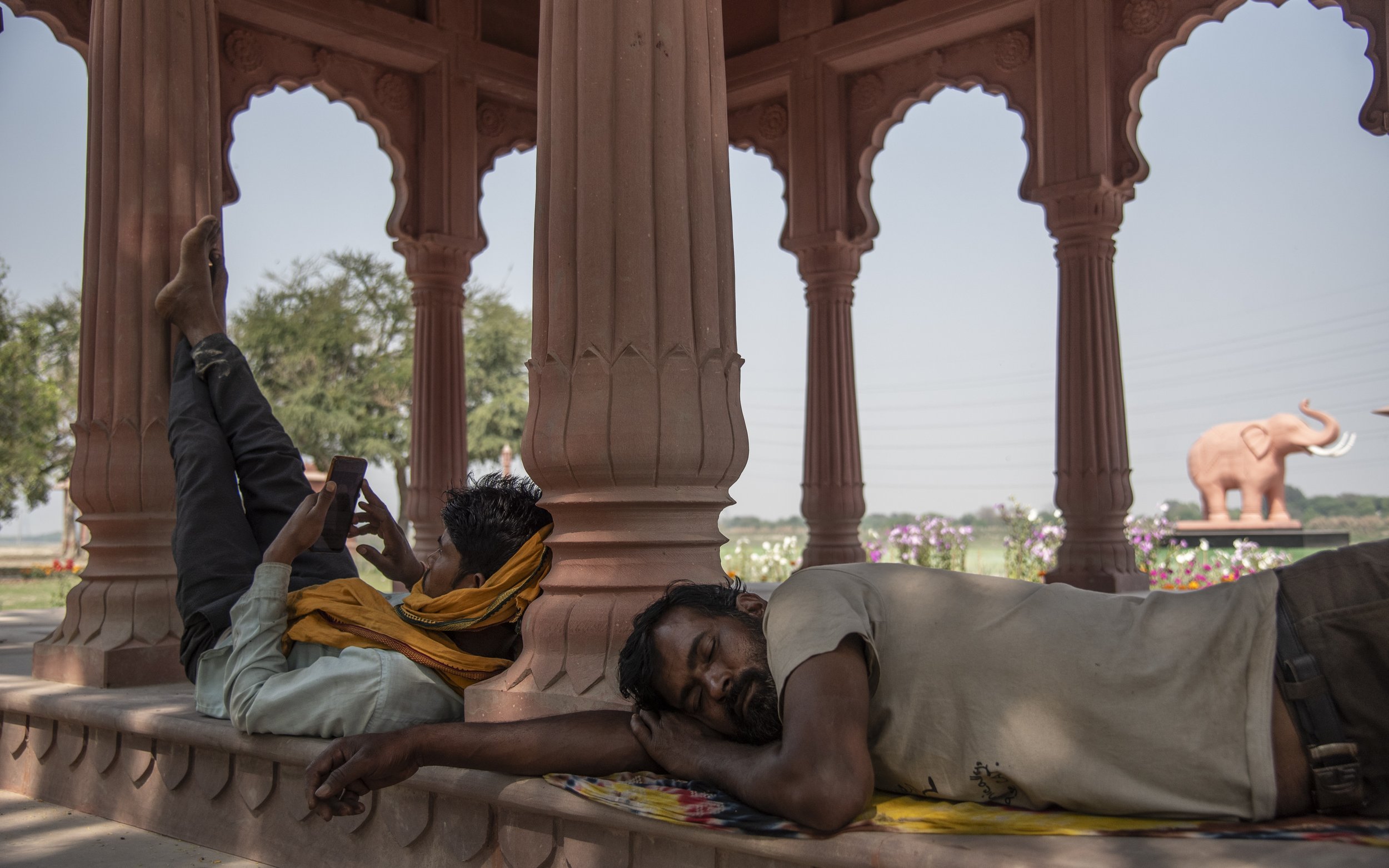A visual and geographic walk in Delhi’s rich greenery, a collection of moments and people, working, eating, exercising or just sleeping in the many gardens of the city, legacy of the centuries, from the early persianate age in India to the last decades of British Raj and finally, independent India.
According to the Delhi Parks and Gardens Society, the National Capital Region boasts more than 18,000 parks and gardens, amounting to roughly 8000 ha in area or a square of 9 km each side. But what’s behind this figure?
Well, since there’s nothing better than a map to explain something about places and space, here is a map I made: a useful guide to learn about the geography of Delhi’s green areas, with 62 of them (a fraction of all of them), from iconic gardens to local parks, including ‘green monuments’, forests and trees from people’s gardens.
Now, browse this map and let images come to your mind: Delhi’s greenery, the Loo, this hot wind of summer sweeping throught the foliage, all these old monuments surrounded by leafy, tranquil treescapes, these silent tombs and forts nested in groves of Babul trees, Gulmohar, Peepal, Amaltas…
It is a cartography of these green moments I am sharing with you, where to find them, what exactly awaits the wanderer in these different parks and woods, how they are laid out spatially and how large or tiny they can be…
The second best thing after a map to tacke this topic is a photo series. Let’s dive in!
Playful colours
Any patch of grass in Delhi is constantly at risk of seeing young boys and teenagers flocking to play cricket on it. Groups of boys -with no girls in sight- enthusiastically play cricket at any time of the day, loudly cheering on the trampled and parched grass whenever one team scores.
The only other thing that may come close to cricket in terms of popularity among the indian youth may be social media, more specifically, making trendy videos in parks, in front landmarks, and four century old walls, like this one pictured here in Isan Khan’s Tomb.
That is yet another kind of green moment.
Another common sight a wanderer is guaranteed to meet in Delhi’s gardens is men in their forties playing cards very calmly, and of course, dogs.
A Hip Hop dancer practicing in a Pavillion of Deer Park, near Hauz Khas.
Even dead trees can become playgrounds, provided they meet the right audience.
A mother watching over her kids, in Sunder Nursery.
A boy holding a cricket bat, in front of a Banyan in Roshanara Bagh, North Delhi.
Just missed the ball. It doesn’t matter. These kids are playing all day long.
Playing cricket in a small park of Ashok Vihar, North Delhi.
Opulence
In Delhi, money has a colour: it’s green. No, it’s not about the rupee notes, it’s about the trees. Just like most metro cities, but even more so in Delhi, wealthy and affluent neighborhoods are considerably greener and dotted with trees providing a soothing urban environment as well as shade during the hottest months. But the greenest moments are kept between tall, heavily guarded and private walls.
Even in the scorching heat of may, servants of this house near Lodhi Gardens make sure the plants stay green and healthy, in the shade of a great Banyan, on the right.
In Sainik Farm, an affluent neighbourhood of South Delhi, most (if not all) houses have their own small ‘bunker’ with a guard standing inside.
Here people don’t live on ‘streets’, ‘marg’ or ‘roads’ : they live on ‘drives’. In the photo on the left, a house on ‘palm drive’. I might as well be somewhere in coastal california, surrounded by multi million dollars villas.
What can these small casemates and tall gates be hiding?
Here is an aerial view to put in perspective how extremely lush and green Sainik farm houses are, compared to their neighbour’s in Sangam Vihar
Once you manage to get past the large gate, you’re greeted with an impeccable lawn and a detached house, a coveited good in Delhi, a bustling city of 25 million.
Good Sleep…
…or just rest
Parks in delhi are some of the only public places where you can expect to find some calm, even silence on rare instances, and enough tranquility to take a nap, in the conforting shade of wide, towering trees. Many people practice this art of sleeping at any time, any place in any position and I’m all for it.
Central Park, Connaught Place.
Green dreams, Central Park, Connaught Place.
Ornamental Garden, Hauz Khas Park
A man sleeping in Vasudev Ghat, a park in construction when I took his photo, nearby the Yamuna river, north of Kashmere Gate.
Eternal Rest, Barber’s Tomb, Humayun Tomb Complex
Fighting the heat
Urban green spaces are a key element in the fight against the urban heat island effect, a dangerous phenomenon produced by the concrete and built up areas absorbing heat in cities and increasing the local air temperature. On a walk on the bank of the Yamuna, I met Dheeraj, using a leaf as a fan, laying down in the sand and certainly not expecting someone to trouble his rest.
He may have been for 10 minutes before I came, or maybe the whole day. I’ll never know.
Ornamental Garden, Hauz Khas Park
Not just in India but in most cities on our planet, poorest neighbourhoods tend to have less green spaces by area and per inhabitants. The scarcity of trees and parks, which cool down the air locally and allow people to escape the heat, is one dangerous ingredient in the lethal cocktail of heat waves, sweeping across many developping countries without access to properly insulated buildings, parks and air conditionning. Morever, their inhabitants are more likely to do physical labour and work in the streets, or in the fields.
Excess heat caused by the urban heat island effect in Delhi was measured to be as high as 7.6°C in some neighborhoods during summer.
In may 2024, parts of Delhi experienced temperatures over 47°C, the kind of heat that can cause heat strokes and kill the most vulnerable. These record breaking temperatures are bound to be more and more frequent as climate change worsens. Green spaces are not some urban planners’ whim.
Green spaces matter.
Lawns along Rajpath and families enjoying a green and refreshing moment in the hot late afternoon.
This leaves us with a question:
what is the geography of parks, gardens and more generally, just trees, in Delhi?
In this other map, let’s have a look at Delhi and most of its neighborhoods (wards), how green they are (any type of vegetation included but more specifically trees and large plants) and how much of their areas is actually made up of parks, gardens, golf courses, public-friendly / walkable forests or woodlands…
As mentionned earlier, when it comes to trees and parks, all places of Delhi are not equal: you can easily spot the poorest neighborhoods just by the light colour, colours that show that most of the area is built up or just bare land (the former accumulating a lot of heat during the day), while the South of Delhi and some other excentric localities are well endowed with parks, partly thanks to a proper urban planning, as opposed to informal / illegal settlements where no space is kept for parks and human density is much greater.
Old stones, young leaves
Gardens and historical landmarks have a long, shared history in Delhi. From the time of the Delhi Sultanate, the Lodi Dynasty, the Mughal Empire and the British Raj, all gave a great importance to gardens, as a refined form of art and discipline, creating beautiful dialogues between the stones and the trees. The Persian Char Bagh (four garden layout) represents Paradise in the Islamic tradition, nothing less.
Because of Delhi’s history, most of its iconic gardens feature tombs or are inside forts dating from the 12th to 16th century and most iconic landmarks, almost always of Persianate / Mughal Architecture, are nested in lush, delicate and flowery gardens. One goes with the other, almost naturally.

Humayun's Tomb and the most striking example of Char Bagh in the city

Women working in Lado Sarai Flower Nursery - Qutb Minar in the background
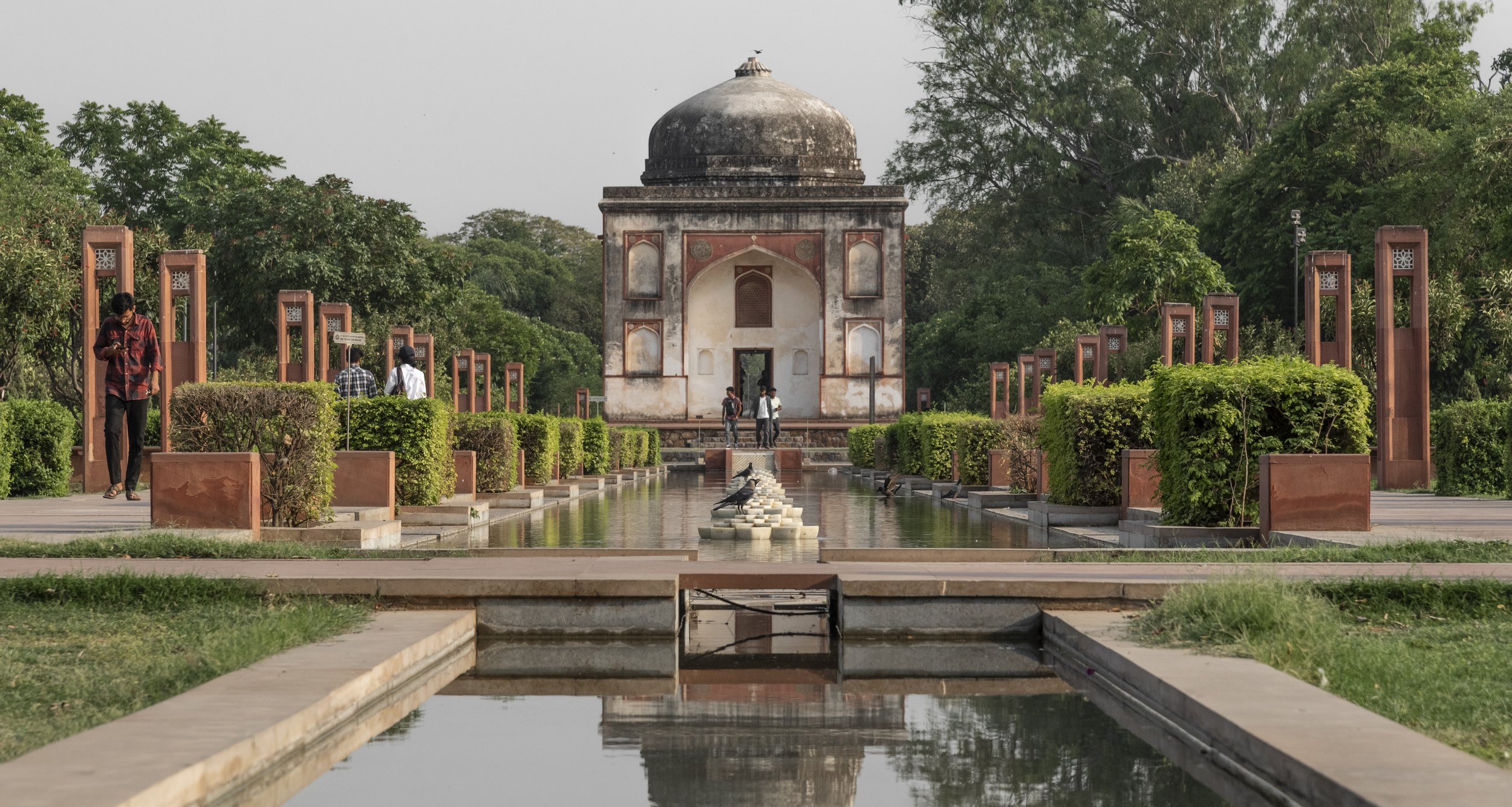
Sunder Wala Burj - Sunder Nursery

Indian Habitat Centre

The Sunheri Masjid, surrounded by Neem trees

Qutb Minar and surrounding lawns and bushes
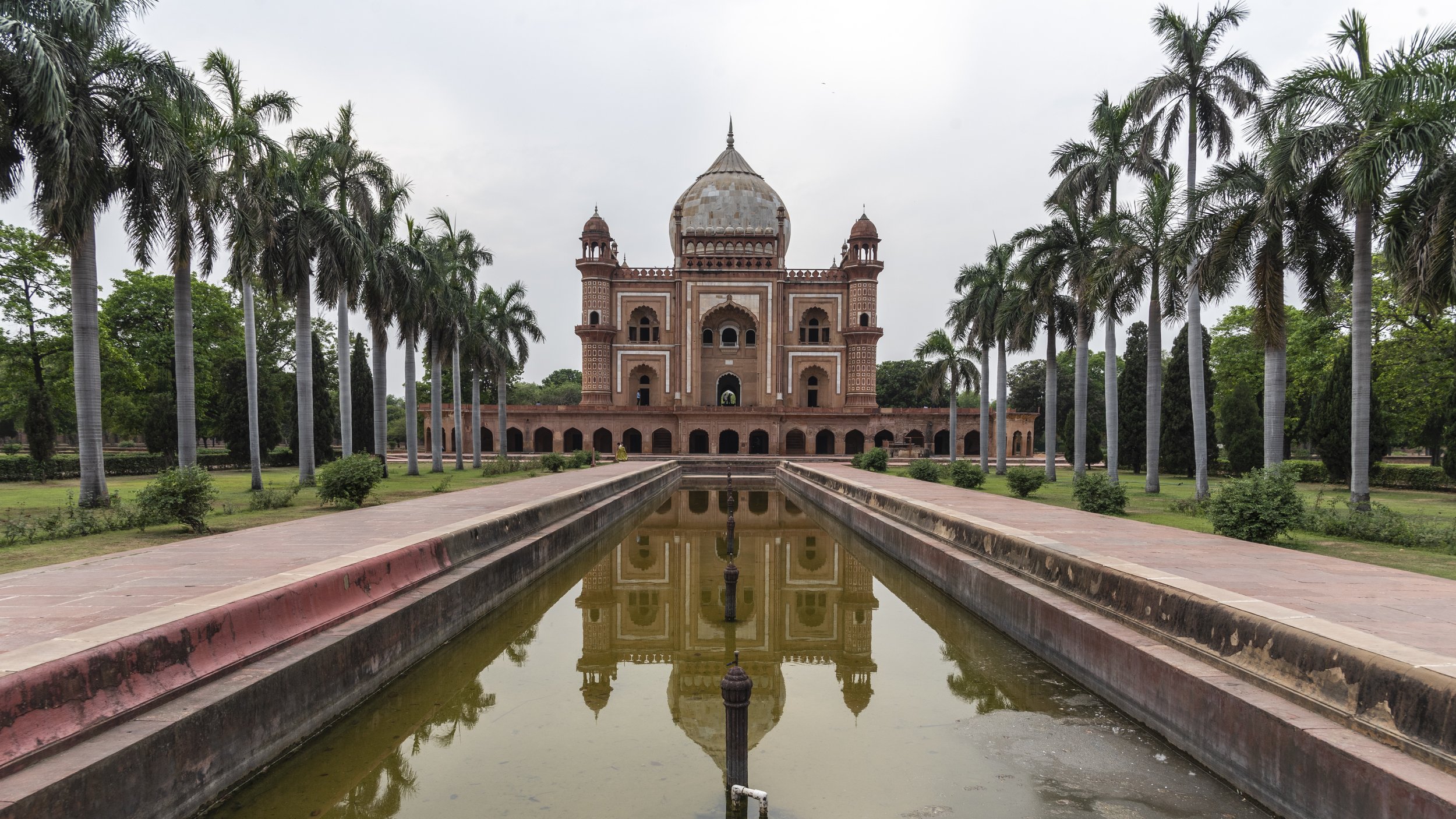
Safdarjung Tomb with Royal Palm trees - a non native species, wide spread in Delhi, that is critised for its water consumption, among other things

Shahi Masjid

Maqdum Sabhzwari mosque and tomb
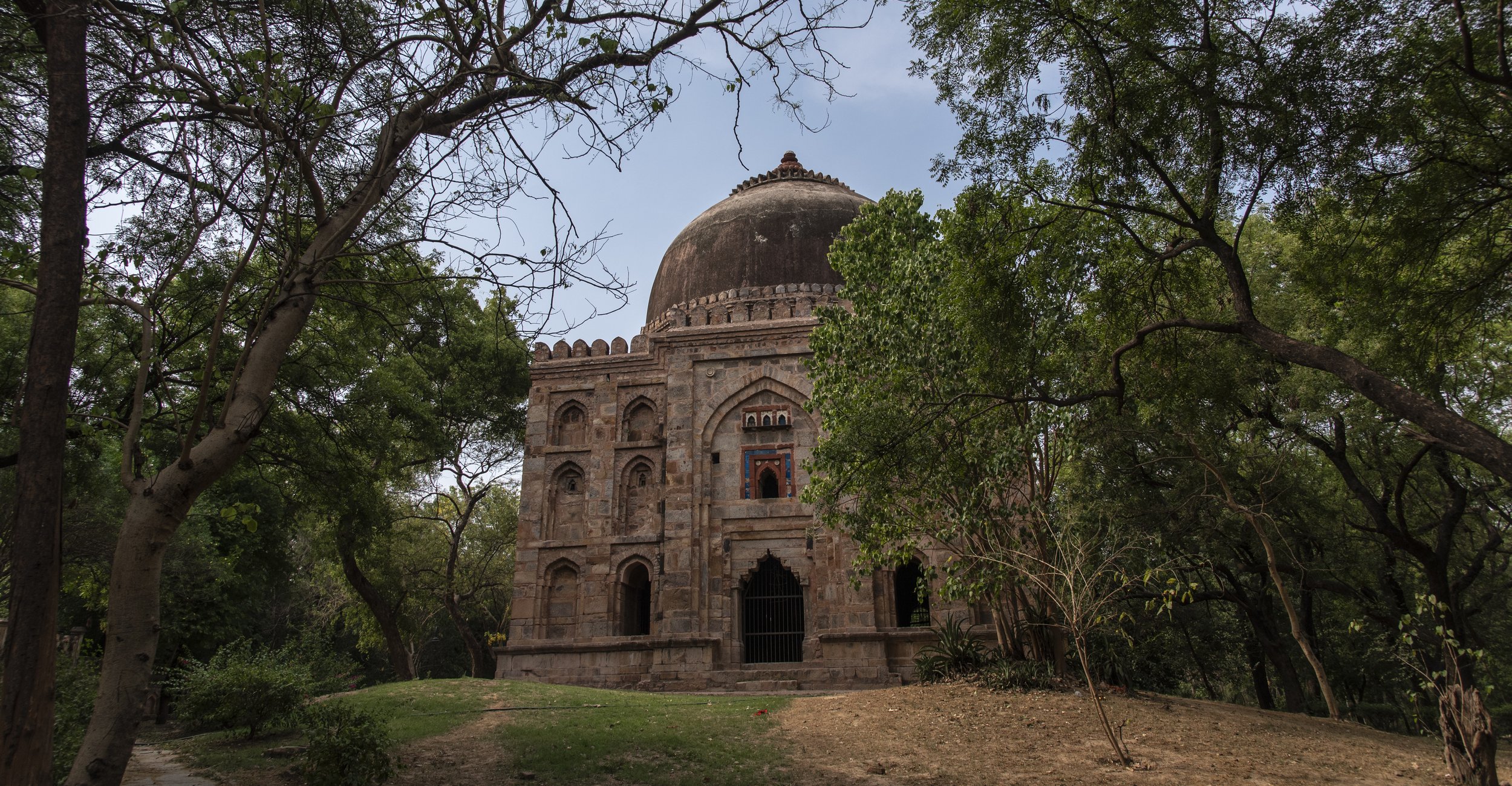
Bagh-I-Alam Ka Gumbad, Deer Park
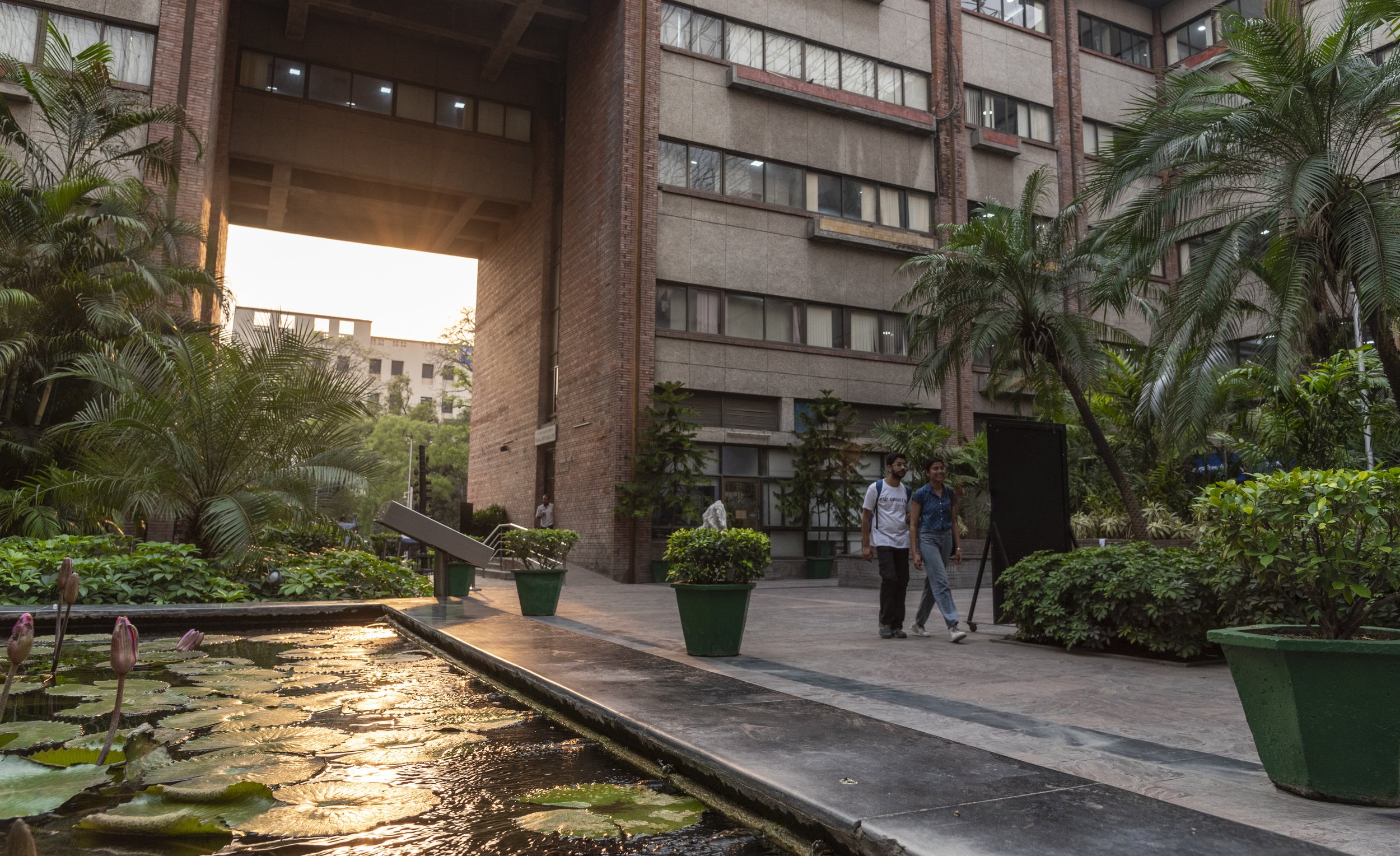
Indian Habitat Centre

Raj Ghat - Gandhi's Memorial
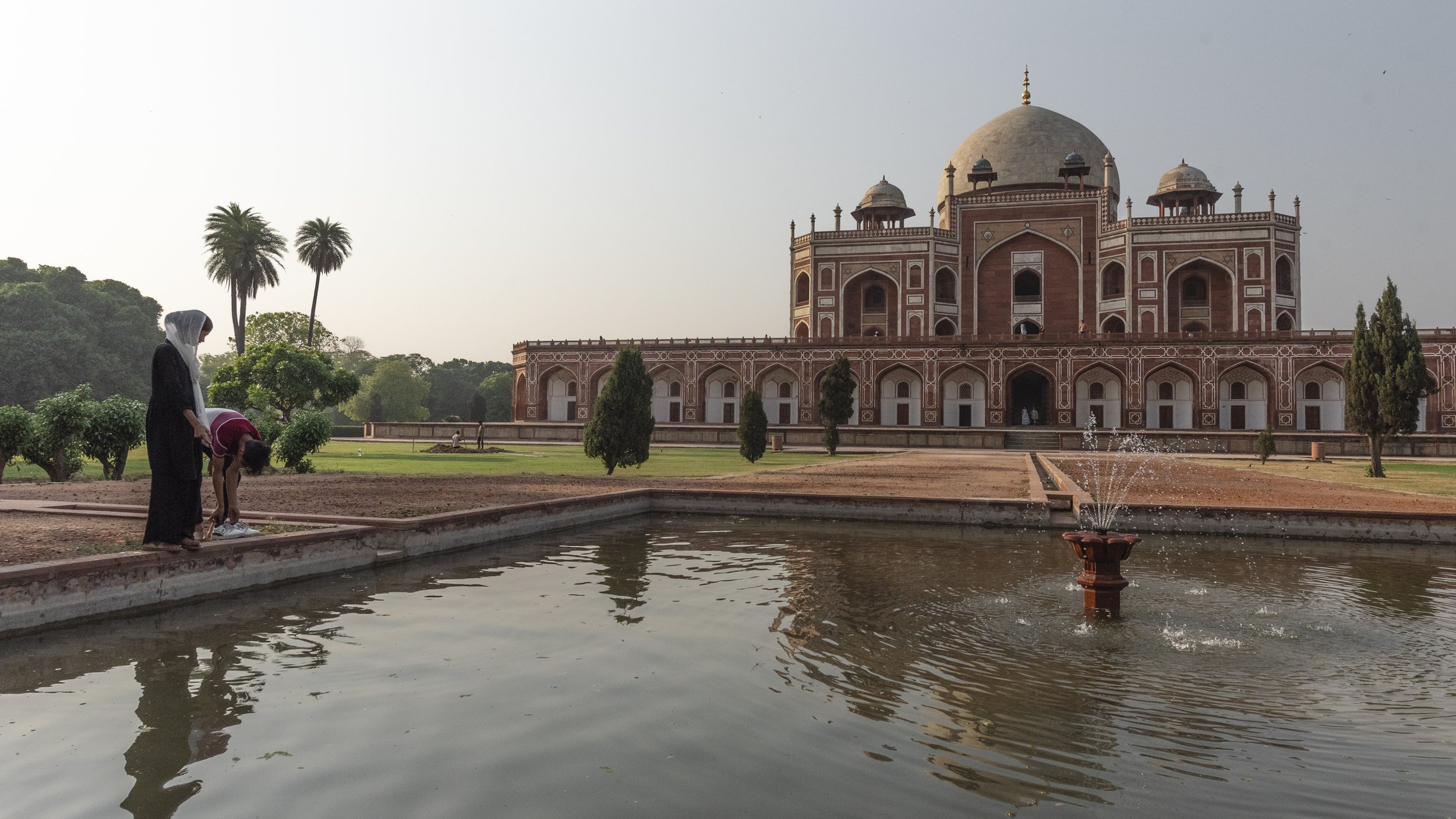
Humayun's Tomb

A Banyan growing on the medieval wall of Delhi, one of the very few remaining parts of it
Sunderwala Burj as seen from the entrance of the park.
Sunder Wala Burj, a 16th century building in Sunder Nursery, a park located on the legendary Grand Trunk Road. It was renovated in 2018 and contains over 300 species of tree, thus becoming Delhi's first arboretum.
Sunder nursery is a garden of particular importance for our topic: it was the place where the British brought seeds from their colonies, so basically from every corner of the world, to conduct botanical experiments, grow saplings and beautify the freshly built New Delhi with exotic trees. The photo below shows hundreds of pots and saplings under the shade of a mature trees.
Playful dogs walking away from Mirza Muzaffar Hussain’s Tomb, Sunder Nursery.
Chlorophyll and power
Gardens and green spaces are more than beautiful botanical arrangement of trees and flowers that speak to artisitc sensibilities: they are places where power is demonstrated in a very eloquent and articulated way.
Actually, one small part of the Estate’s garden, Amrit Udyan -formerly the Mughal Gardens due to its Char Bagh design- is open to the public during a specific time of the year, a few weeks of spring, when all the flowers bloom under the towering figures of the buildings designed by Lutyens more than a century ago
The India Gate (and the surrounding India Gate Park) is a monumental arch built in 1931 by the British, soon after New Delhi was built and became British India’s capital.
The landmark attracts thousands everyday and from its two large sandstone legs, a large avenue unrolls: the Rajpath (formerly known as the Kings Way) dotted with trees and lawns.
It is 2 kilometers long, bordered by official buildings like Ministeries, the National Museum or the Parliament and each year, military parades walk along it for national festivities and ceremonies.
Rajpath was built by the British and, unsurpisingly, feels very European in design and aesthetics. So European in fact, that as a Frenchman it can’t fail to remind me of Paris and its most famous avenue, the ‘Champs Élysées’. In the second half of the 19th century, Baron Haussman cleared slums and medieval houses in Paris to make way for wide, long, straight and geometrical avenues piercing through the heart of Paris, creating tall, uniform buildings and freeing up space for parks and gardens that we know today and are part of Paris’ urban identity.
See the full map at the beginning of the article
Reasons for this radical urban decision were partly hygenic, related to the beautification of the city and most importantly, Order. This was a way of keeping the protesters and revolutionaries in check, as heavy social turmoil was a regular occurence in the 19th century Paris, with its many narrow and winding roads.
Pictured here, the Rashtrapati Bhavan -the President’s Estate- also built by the British, a highly authoritative building surrounded by fantastic gardens shown below. As indicated by this barrier, this is the line where the greenery switches from ‘public’ and ‘free’ to’ VIP’ and ‘restricted'.
Gardens and wide green spaces also happen to be the perfect place for display of tall and visible flags, a very common sight in Delhi, even in small and local parks, shared in a residential block (with flags matching the park’s scale in size). Pictured here, the 9 by 18 m flag, the largest one in all of India, located in Central Park (Connaught place).
On the right, the windows of the metro station Rajiv Chowk, one of Delhi’s busiest metro station that goes just underneath the palm trees and tranquil wanderers of the park.
Natural Shapes
Let’s also not forget that gardens are places of inspiration and natural shapes. Delhi features a vast array of trees, some native to the humid subtropical climate, bordering on a hot semi-arid one, while many others were imported by the merchants, rulers and invaders, especially the british during the nineteenth century, a time of great exchange for flowers and trees around the world.
Some of these trees are ornamental, like the jamun, neem, arjun, imli or the peepal, bordering the very green avenues of New Delhi, the planned city built by the british. Others are native and can be found in wild conditions, in some of the very last remaining forests of Delhi, or for example in the Buddha Jayanti park, itself located on the Aravalli Hills that crosses Delhi. The Aravalli Hills is arguably the oldest geomorphological feature on earth. Keep this in mind for the time you plan to walk there!
You can find below a photo of colourful tree shot in the Buddha Jayanti park.

Gulmohar flowers, Lodhi Gardens

Banyan leaves in Hauz Khas Forest

Crops on the Yamuna Banks

Palm and frangipani trees

Trees in Lodhi Gardens

Trees in Buddha Jayanti Park
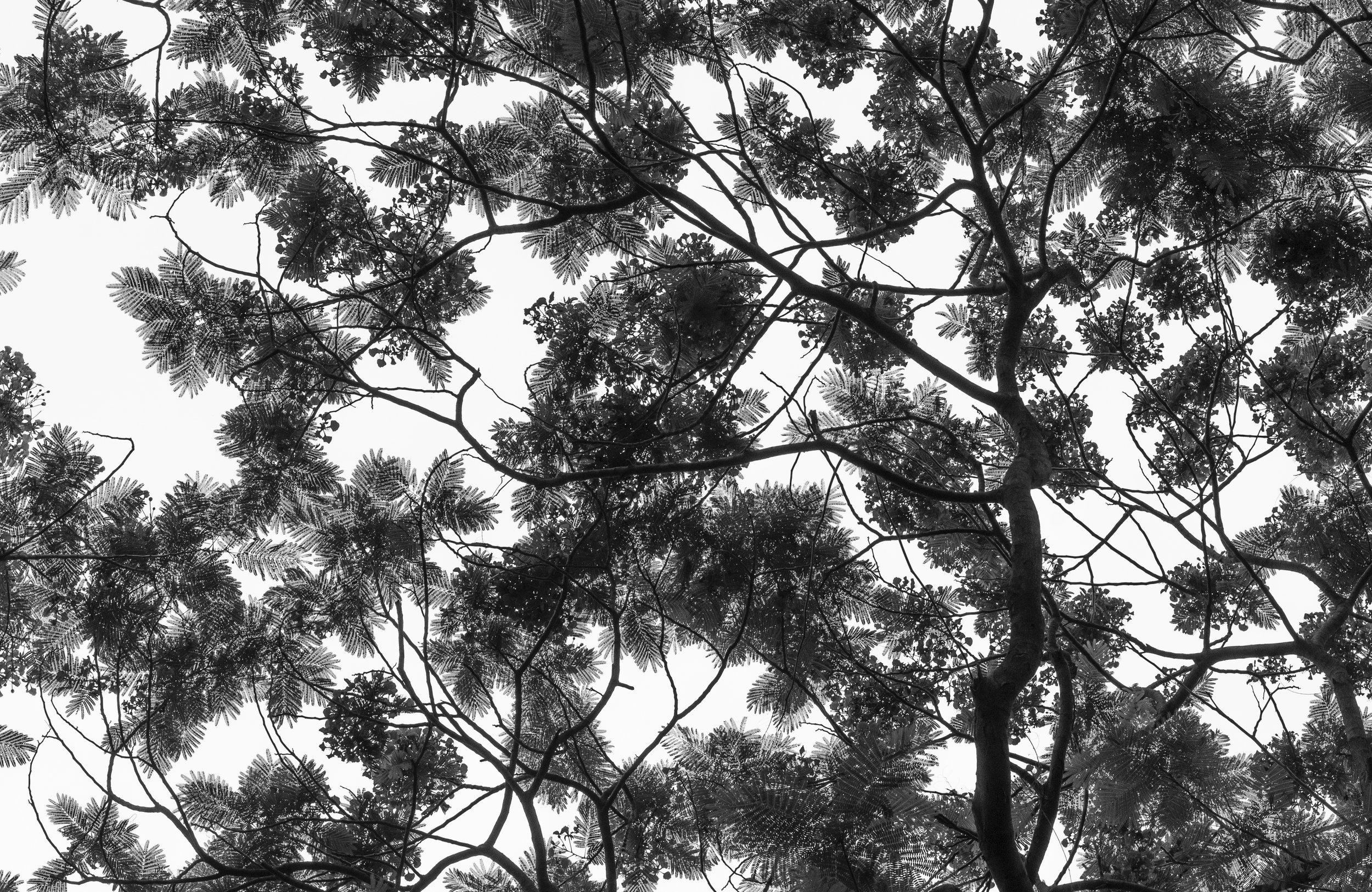
Canopy in Lodhi Gardens
Health
Here’s another great power trees and green spaces are endowed with: providing a space for exercising and well being, especially in cities where they offer some respite for the heart and the soul.
Concrete and leaves: when the mineral and vegetal worlds merge and coexist, with urban humans intersecting in the middle.
Men in their forties or older often meet each other, same age and same colony (the indian english word for urban locality or neighborhood) during the morning for various exercises meant to improve mental and physical health.
Here, in this small park of Ashok Vihar, these men are chanting a mantra to Krishna just after completing 5 minutes of laughter Yoga that I could hear from my balcony, triggering my curiosity.
They will say then goodbye to each other and take leave until the next morning.
Built on what used to be the Yamuna floodplains, an important natural buffer more and more threatened, the Yamuna park is a lively area built under the noisy ring road, north of the city.
The place stills provides calm and soothing sights, where people from the nearby tibetan refugee colony of Majnu ka Tilla come to exercise and meditate every morning.
A man meditates under the shade of a large tropical tree, a thousand of year old scene, recreated in 21st century Delhi.
Pranayam Yoga, a form of Yoga that focuses on the breath, is mentionned in the two thousand year old Bhagavad Gita but hasn’t lost any of its popularity today.
Inspiration
Artists of all time have been inspired by nature and some of the finest painters of the early 20th century such as Monet, Renoir, Van Gogh, Cézanne and others were drawn to gardens where they found inspiration and beauty in vegetal shapes, flowers, trees, their colours and the atmosphere you find in places filled with them. Artists of Delhi are no exception!
On the other side of the same building, Bada Gumbad, I meet an artist, Anubhav Priya who decided to build a camera himself. It is a camera obscura, as he explains to me, built in the most rudimentary but ingenious way, using cardboard, tape and a basic lens to take photographs of the monuments of Lodhi Gardens with a process known as cyanoptype.
On the third side of Bada Gumbad, I meet two art students sketching the beautiful dome, Gumbad in Persian, of the 15th century monument. One building, three pieces of art.
Cycles
To end this visual walk through Delhi’s trees, plants, gardens, and people we find in them, here is a last photo of Prem Singh, a farmer I met in the middle of a mosaic of green crops on the Yamuna floodplain, north of the city. He is a 74-year-old retired government worker and has been growing food for 60 years. 60 years, 60 cycles. We see him sorting spinach leaves with the Signature bridge in the background, that crosses the Yamuna river.
Nature may look quite tame in the mega-city that is Delhi: concrete embankments, fancy bridges, and roads, but every summer, during the monsoon season, the deities of rivers, mountains, and rains all combine their forces, while nature, through rivers, undergoes a violent surge that reminds city folk of the sheer force and raw power of the elements. The Yamuna and many other Indian rivers swell, widen, engulf, and swallow hundreds of square kilometers of flood plains, fertilizing and renewing them, giving them nutrients—and, sadly, pollutants—that fertilise them.
Prem Singh’s crop is no exception: the very first civilizations emerged on river floodplains, and the cycle has continued ever since, an age-old cycle that has been unfolding, every year, for thousands of years. So many years, so many summers have seen the black clouds of monsoon rain gather in the angry skies and when they burst, feed rivers and make the city green again.
A group of fashion design students are taking pictures of a fellow student wearing clothes that they designed, inspired by the Apsaras, mythological hindu nymphs, with the Bada Gumbad of Lodhi Gardens as a background.
Acknowledgements
I owe this work and the inspiration that led to it to the fantastic book of Pradeep Krishen, ‘Trees of Delhi: a field guide"‘.
Thank you Pradeep!
I also hope to come next year to Delhi during the winter and explore more of its natural and semi natural spaces: Yamuna Biodiversity Park, the Aravelli Forests, the wet zones and ornithological reserves along the Yamuna… stay tuned!
Thanks for reading!
See the complete photo gallery of these two months I spent in India
What if all the glaciers melted? See a new map of India


















